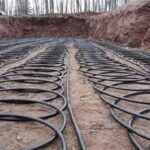
Geothermal heating is a viable alternative to the more traditional forms of fossil fuel heating using the vast thermal temperatures beneath our feet to heat and cool our homes since the ground temperatures don’t change much no matter how warm or cold or warm it gets outside. How deep is geothermal heating loops depends whether the loops are placed horizontally or vertically
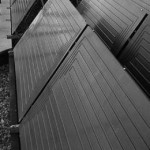
Solar thermodynamic heating systems use solar energy to heat water in the home. Thermodynamic solar panels absorb the environmental heat around themeselves to heat up water for a range of different uses, from domestic hot water to home central heating systems, to swimming pool heating. Thermodynamic solar collector use a heat transfer fluid refridgerant which can heat water 24 hours a day. Unlike conventional flat plate solar panels, solar thermodynamic heating systems do not require direct sunlight and can produce heat no matter what the weather conditions even at night, in rain or on overcast days

Heat exchanger design has changed very little over the years but their importance in terms of energy conservation, conversion, recovery, and successful implementation of new energy sources has. Heat exchangers are used in many power, heat-recovery, process, transportation and refrigeration applications, so the choice of heat exchanger thermal design is important. Fan assisted finned type heat exchangers are the most commonly used design mainly because they are cheap, while water cooled heat exchanger designs are more efficient but expensive
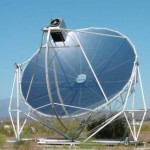
The Stirling Engine is a heat engine design that operates by the cyclic compression and expansion of various gases at different temperatures. A Stirling engine is a closed-cycle regenerative heat engine which uses a gaseous working fluid permanently contained within the system to produce mechanical movement to drive an electrical generator. The heat source used to drive a Stirling engine is generally concentrated solar energy but solid waste heat and bioenergy can also be used
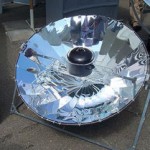
Solar cookers and ovens use the thermal energy of the sun to cook food. Traditionally cooking food outdoors requires stoves and wood as fuel, but climate-friendly solar cookers do not burn non-renewable charcoal or firewood resulting in zero CO2 emissions and less smoke, soot and ash. Solar box cookers and ovens use a free, and effectively inexhaustible source of thermal energy from the sun to cook food inside at high temperatures. Solar irradiance plays a vital role in cooking with the sun, so its only cloudy dull days that restricts the use of solar box cookers
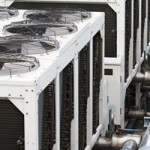
Solar cooling removes the need for refrigeration and air conditioning systems which can dramaticly increase electricity consumption and therefore greenhouse gas emissions. Solar cooling systems can save energy in comparison to conventional cooling technologies as their main design and operation uses solar energy. The advantage here is that any air conditioning and cooling requirements is at its highest when the solar irradiation is abundantly available so the cooling demand produced from solar energy is immediately used

Concentrated solar power uses mirrors, lenses or parabolic dishes to concentrate the sun’s rays and energy to small area producing enormous amounts of heat used to generate electricity. Concentrated solar power offers many environmental benefits compared to conventional nonrenewable energy sources because of the reduced green house gas emissions and air pollution and waste. However, concentrated solar power does requires the potential use of large areas of land in sunny areas to collect sufficient sunlight and high working temperatures to produce usable energy
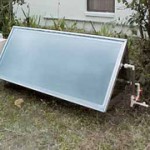
Solar batch water heaters are thermal solar collectors heated by the energy from the sun. Batch-type solar hot water heaters are among the most cost effective and simple to construct and use solar device. They can be used alone to provide hot water at temperatures which can fluctuate with the time of day and weather, or they can be used to preheat mains water water feeding into an existing water heater to reduce the fuel costs of bringing the cold water upto a preset temperature. Solar batch water heaters can be as simple as a series of pipes inside a glazed and insulated box to collect the solar energy, or large tanks configured for pumped circulation of anti-freeze heat transfer fluid
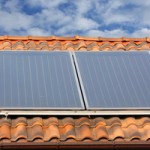
Solar thermal energy uses the suns energy to heat water making solar thermal a viable solution for any future renewable energy heating system. As solar power is the main source of energy from the sun, different technologies exist in the form of solar heating and solar thermal power generation to reduce our dependency on more conventional fossil fuels. Solar thermal energy has a lower environmental impact, zero CO2 emissions or produce other toxic gases like the ones used to produce our current energy production. Solar domestic hot water systems use the sun’s energy collected by flat-plate solar collectors or tubes to transfer the suns heat to water or another liquid
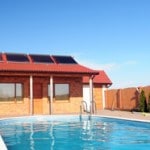
Swimming pool heating systems use solar energy or heat pump technology to heat the water of a pool during the day. Solar thermal technology and heat pumps have long been used to heat houses and produce domestic hot water but they can also be used to heat your pool. During the summer months when the solar irradiance is strong, solar thermal panels and pumps can be used to heat water. In the cooler months when the temperatures drop, geothermal or hot air heat pumps can be used. Using solar energy can more than double your swim season as long as the sun keeps shining